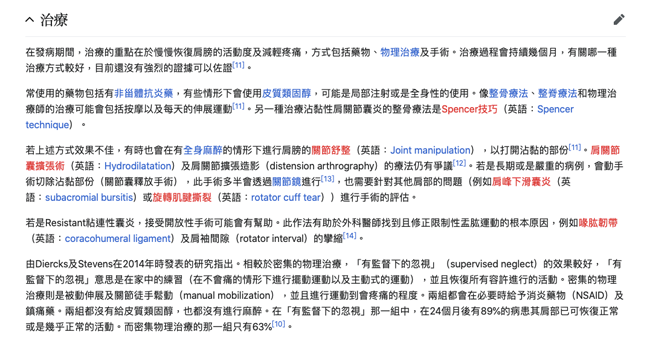五十肩怎麼治療?解析預後、物理治療與注射手段的真相
老師我有問題系列之
五十肩預後和治療方式的建議
平均來說五十肩會在1-2年改善,從極度疼痛到活動角度逐漸恢復,但不完全好(有些人活動角度依然沒有完全恢復),這個預後的大前提是你有正確診斷、了解自然病程、如何自我照護以及主動治療。
物理治療包含運動、徒手、衛教、儀器。
不同徒手手法(筋膜、關節鬆動術…等),搭配儀器(震波、超音波、電療等),或搭配運動、肌力訓練,彼此排列組合,都比只做單一項有效。
例如:
- 基礎的旋轉肌群肌力訓練搭配電療、關節鬆動術,比只做電療和關節鬆動術更可降低疼痛、增加功能和角度。
- 體外震波加上物理治療對疼痛有長期改善效益。
- 關節內注射生理食鹽水/類固醇,搭配物理治療較單獨做注射,更可以促進肩膀功能 (Nakandala et al., 2021)。
Hydrodilatation注射生理食鹽水又稱關節擴張術
- 短期(第一至三個月)止痛效果較其他注射方式佳,一年後與其他注射方式無差異。但它不是萬靈丹,研究顯示需要施打12人,裡面才會有1人有效 (Yoon et al., 2016)。
- 注射類固醇 (corticosteroid) 短期 (4-8週) 在肩功能表現上較物理治療有效,隨時間拉長效果遞減 (Blanchard et al., 2010)。
- 多次注射不會比較有效 (Erickson et al., 2019)。與口服NSAIDs比較,12週下來,注射較能止痛、促進功能 (Ranalletta et al., 2016)。
* 五十肩前期真的很痛,會建議注射生理食鹽水或打關節內類固醇,搭配物理治療可以減少再次注射,效果也會更顯著。 注射類固醇後有去物理治療者再次接受注射的比例只有27%,注射後沒有去物理治療再次接受注射比例是100%。
關節鏡關節囊放鬆術和麻醉下鬆動術無顯著差異 (Grant et al., 2013)。
麻醉下鬆動和家裡運動在3個月、6個月、一年追蹤比較無臨床顯著差異 (Kivimäki et al., 2007)。
17% 的人麻醉下鬆動術後需要再次治療 (Woods et al., 2017)。
90% 的人保守治療就有效,千萬不要傻傻等它自然好,或是自己拉單槓拉到受傷。依照不同期程,選擇適合自己的方式,可以幫助加快復原,最大化生活品質!

【題外話】
查詢資料時 ,我在維基百科看到的內容 ,文中表示相較於密集的物理治療,「有監督下忽視」效果更好,我認為只用一篇證據層級不高的研究來說效果,容易造成大眾誤解,是不負責任的行為。
Gentle thawing of the frozen shoulder: a prospective study of supervised neglect versus intensive physical therapy in seventy-seven patients with frozen shoulder syndrome followed up for two years 2004年前瞻性研究,追蹤77位五十肩患者,2年期間比較Constant-Murley肩關節評分量表
實驗組:監督下忽略(衛教五十肩自然病程、給予保證、請病人在可忍受的疼痛範圍內保持肩膀活動、建議活動方式)
控制組:密集物理治療(做被動牽拉、關節鬆動術且超過可忍受疼痛範圍,一週2次直至2年)
結果顯示:2年後監督下忽略比密集物理治療在肩關節評分量表表現較佳,密集的物理治療似乎在前3個月對五十肩有反效果,這個研究好像代表物理治療無效?
我認為這樣總結太過於粗糙,第一物理治療不是只有徒手技術而已,我們在臨床上,需要非常多的衛教溝通、再保證、以及教導運動方式;研究設計在控制組進行2年下來,只被動接受治療?而不告訴病人怎麼面對疼痛、怎麼動得輕鬆?!。
那麼文章只能表示『只接受被動徒手治療』,對五十肩的病人來說幫助不大,更應該要懂的病程,以及如何動、持續動。
最後,準實驗研究設計(quasi-experimental design):僅具備實驗組和控制組以及前後時間點的測量,即為準時驗研究設計。所以研究沒有隨機分配、各組男女分布不均、評估者跟受測者沒有遮盲,這在研究的證據層級是低的。
我舉例這篇2014年 RCT文獻,馬上打臉上一篇,發現有比監督下忽略的效果更好的方式。
將符合條件的75位病人隨機分配到
第一組:物理治療師監督下的團體運動課50分鐘/次,2次/週,共6週+回家功課
第二組:一對一接受多元模式式物理治療(運動、徒手、儀器)2次/週,共6週+回家功課
第三組:獨自執行回家功課(監督下忽略)
*每一組都有衛教手冊,介紹五十肩自然病程,運動方式指導與建議方便在家執行功課
介入6週結果發現:
臨床最小重要差異值MCID constant score>15 監督團體運動組(91%超過MCID)/一對一物理治療(68%達到MCID)/獨自執行回家功課組(41%達到MCID)也就是3者在肩膀功能量表都有進步。統計學來看:效果最顯著是
團體運動課 >>> 一對一物理治療 >>>獨自執行回家功課(監督下忽略)
• 監督下團體運動在介入後(6個月、1年)追蹤,肩膀功能分數仍較其他組顯著
• 焦慮程度下降在一對一接受多元模式式物理治療組最顯著
• 團體運動挺好(同儕支持、歸屬感)有動機、降低焦慮、增加自我效能
*閱讀文獻是一回事,要如何解讀與運用文獻又是另一回事
資料來源
Diercks, R. L., & Stevens, M. (2004). Gentle thawing of the frozen shoulder: a prospective study of supervised neglect versus intensive physical therapy in seventy-seven patients with frozen shoulder syndrome followed up for two years. Journal of Shoulder and Elbow Surgery, 13(5), 499-502.
Rawat, P., Eapen, C., & Seema, K. P. (2017). Effect of rotator cuff strengthening as an adjunct to standard care in subjects with adhesive capsulitis: A randomized controlled trial. Journal of Hand Therapy, 30(3), 235-241.
Russell, S., Jariwala, A., Conlon, R., Selfe, J., Richards, J., & Walton, M. (2014). A blinded, randomized, controlled trial assessing conservative management strategies for frozen shoulder. Journal of shoulder and elbow surgery, 23(4), 500-507.
Nakandala, P., Nanayakkara, I., Wadugodapitiya, S., & Gawarammana, I. (2021). The efficacy of physiotherapy interventions in the treatment of adhesive capsulitis: A systematic review. Journal of Back and Musculoskeletal Rehabilitation, 34(2), 195-205.
Yoon, J. P., Chung, S. W., Kim, J. E., Kim, H. S., Lee, H. J., Jeong, W. J., ... & Kim, Y. (2016). Intra-articular injection, subacromial injection, and hydrodilatation for primary frozen shoulder: a randomized clinical trial. Journal of shoulder and elbow surgery, 25(3), 376-383.
Sharma, S. P., Bærheim, A., Moe-Nilssen, R., & Kvåle, A. (2016). Adhesive capsulitis of the shoulder, treatment with corticosteroid, corticosteroid with distension or treatment-as-usual; a randomised controlled trial in primary care. BMC musculoskeletal disorders, 17(1), 1-10.
Blanchard, V., Barr, S., & Cerisola, F. L. (2010). The effectiveness of corticosteroid injections compared with physiotherapeutic interventions for adhesive capsulitis: a systematic review. Physiotherapy, 96(2), 95-107.
Saltychev, M., Laimi, K., Virolainen, P., & Fredericson, M. (2018). Effectiveness of hydrodilatation in adhesive capsulitis of shoulder: a systematic review and meta-analysis. Scandinavian Journal of Surgery, 107(4), 285-293.
Erickson, B. J., Shishani, Y., Bishop, M. E., Romeo, A. A., & Gobezie, R. (2019). Adhesive capsulitis: Demographics and predictive factors for success following steroid injections and surgical intervention. Arthroscopy, sports medicine, and rehabilitation, 1(1), e35-e40.
Ranalletta, M., Rossi, L. A., Bongiovanni, S. L., Tanoira, I., Elizondo, C. M., & Maignon, G. D. (2016). Corticosteroid injections accelerate pain relief and recovery of function compared with oral NSAIDs in patients with adhesive capsulitis: a randomized controlled trial. The American journal of sports medicine, 44(2), 474-481.
Kivimäki, J., Pohjolainen, T., Malmivaara, A., Kannisto, M., Guillaume, J., Seitsalo, S., & Nissinen, M. (2007). Manipulation under anesthesia with home exercises versus home exercises alone in the treatment of frozen shoulder: a randomized, controlled trial with 125 patients. Journal of Shoulder and Elbow Surgery, 16(6), 722-726.
Woods, D. A., & Loganathan, K. (2017). Recurrence of frozen shoulder after manipulation under anaesthetic (MUA) the results of repeating the MUA. The Bone & Joint Journal, 99(6), 812-817.
Grant, J. A., Schroeder, N., Miller, B. S., & Carpenter, J. E. (2013). Comparison of manipulation and arthroscopic capsular release for adhesive capsulitis: a systematic review. Journal of Shoulder and Elbow Surgery, 22(8), 1135-1145.
*僅分享保健醫藥學資訊,不能取代專業醫學建議、診斷或治療。


